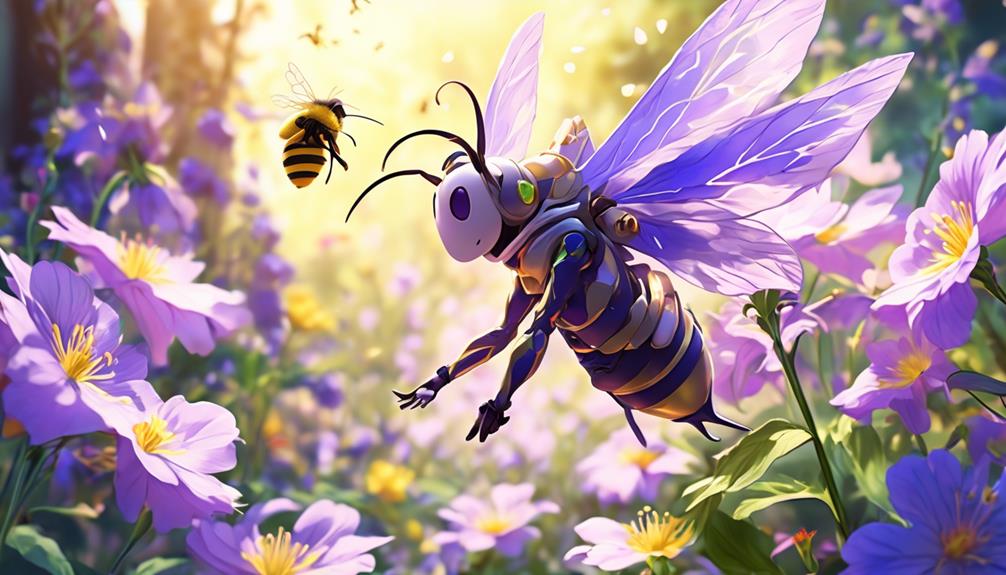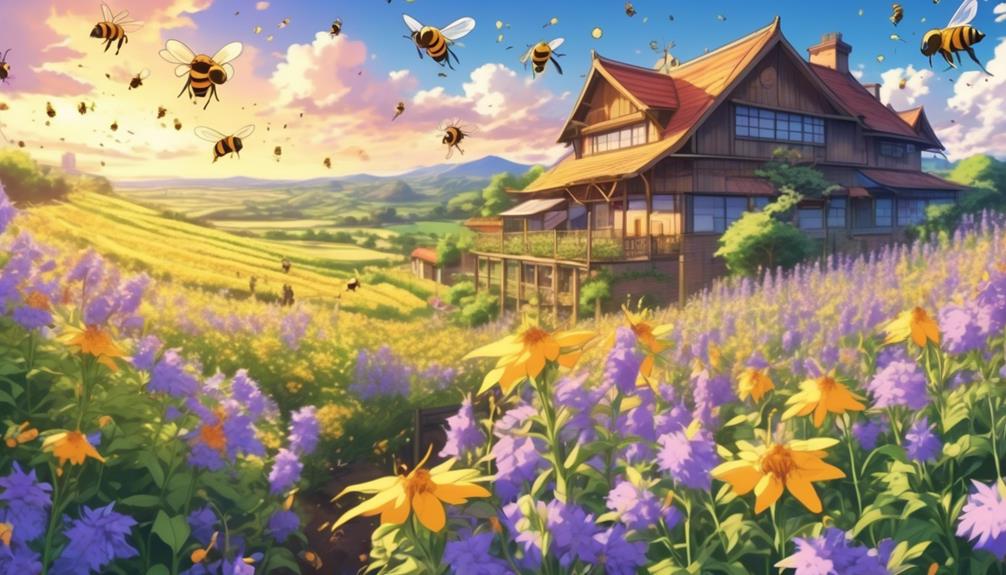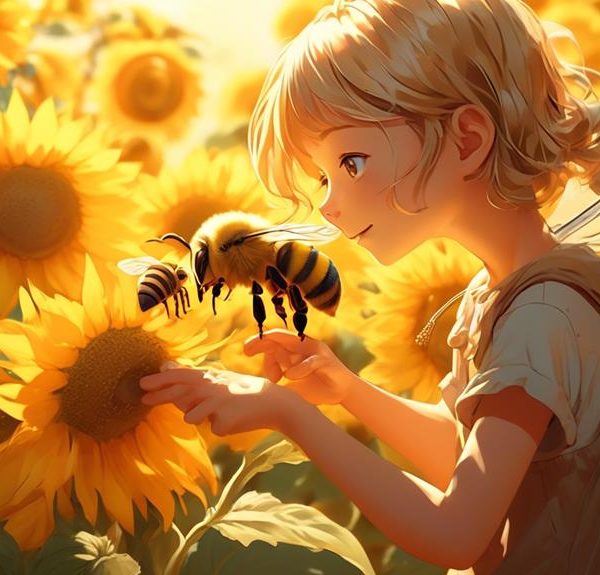Bellflowers and bees share a unique bond; explore the fascinating reasons behind this unexpected preference in the world of pollinators.

Do Bees Like Bellflowers
Bumbling bees buzzing around beautiful bellflowers are a common sight in many gardens. You've probably noticed that these tiny workers seem particularly drawn to the bell-shaped blooms, but have you ever wondered why? Do bees actually prefer bellflowers over other types of flowers, or is it just a coincidence?
While it's not a question that will change the course of history, understanding these intricate relationships in nature can give you a deeper appreciation of the world around you. So, let's start to unravel this intriguing puzzle together.
Key Takeaways
- Bees are attracted to bellflowers due to their shape, color, and the nectar they provide.
- Bees have a keen sense of smell and can detect specific floral scents, like those of bellflowers.
- Bees' preferences for bellflowers are shaped by learning and memory.
- Bellflowers play a crucial role in supporting bee nutrition, promoting plant reproduction, and enhancing agricultural yields through pollination.
Understanding Bee Behavior and Preferences

To truly delve into the realm of bees and their preferences, you'll need to comprehend the intricacies of their behavior, including their predilection for certain flowers like bellflowers. Bees' choices aren't random; they're driven by specific factors. For instance, they're attracted to bellflowers due to their shape, color, and the nectar they provide.
Understanding bees' foraging behaviors requires a grasp of their perceptual abilities. They're able to discern colors, patterns, and shapes, which guide them to preferred flowers. You might've noticed their affinity for flowers exhibiting radial symmetry, like bellflowers. This makes sense as these flowers often signal a rich source of nectar, a primary energy source for bees.
Furthermore, bees have evolved a keen sense of smell. They can detect specific floral scents, like those of bellflowers, from a considerable distance. These aromas serve as an olfactory lighthouse, guiding bees to their floral targets.
Lastly, bees' preferences are shaped by learning and memory. They're capable of associative learning, linking flower traits to rewarding nectar. Once such a connection is established, bees will repeatedly visit similar flowers, hence their fondness for bellflowers.
The Allure of Bellflowers for Bees

Having understood why bees are drawn to certain flowers, let's now examine the specific allure of bellflowers for these industrious insects. Bellflowers, or Campanula, possess attributes that make them particularly attractive to bees.
These perennial flowers have a bell-like shape, hence the name. This shape is optimal for bees, as it provides easy access to the flower's nectar and pollen. The stamens of bellflowers are positioned perfectly to brush against a bee's body, resulting in efficient pollination.
Bellflower's vibrant blue or purple hues are highly appealing to bees. You see, bees can't perceive red or pink hues and so, they gravitate towards flowers with blue and violet tones.
Moreover, bellflowers produce a considerable amount of nectar. A bee's primary diet consists of nectar and pollen, so a generous nectar supply is a major draw.
Lastly, bellflowers have a long blooming period, from late spring to early fall. This provides a steady food supply for bees, increasing the flower's attractiveness.
Impact on Ecosystem and Agriculture

Let's dive into the significant impact that the relationship between bees and bellflowers has on both our ecosystem and agricultural practices. Bees, as primary pollinators, are vital in maintaining biodiversity, while bellflowers, being a favorite among bees, play their part in bee nutrition and survival. This synergy ensures a healthy ecosystem and robust agricultural yields.
In the ecosystem, bees pollinate bellflowers, promoting plant reproduction and genetic diversity. This process supports a variety of life forms, from insects to larger animals that feed on these plants or other animals that depend on them.
In agriculture, bellflowers attract bees to fields, indirectly enhancing the pollination of crops. This contributes to better fruit set and crop yield. The table below provides a snapshot of these impacts:
Ecosystem Impact | Agricultural Impact |
|---|---|
Promotes biodiversity | Improves crop yield |
Supports food chain | Enhances fruit set |
Encourages plant reproduction | Attracts pollinators |
Understanding this relationship is crucial to preserving our environment and ensuring food security. As you can see, the simple act of a bee visiting a bellflower has far-reaching effects, and it's something we should strive to support and protect.
Encouraging Bees With Bellflowers

By planting bellflowers in your garden, you can create a bee-friendly environment, encouraging these essential pollinators to thrive and continue their critical work within our ecosystem. Bellflowers, with their tube-like shape, are particularly appealing to bees as they allow for easy access to nectar.
To ensure maximum bee attraction, it's important to plant bellflowers in clusters. Bees are more likely to visit large, dense patches of flowers rather than isolated ones. So, strategically placing these clusters in sunny spots, you'll create an inviting buffet for these pollinators.
It's also vital to consider the timing of your bellflower blooms. Bees need a continuous source of food throughout their active seasons. By selecting a variety of bellflowers that bloom at different times, you'll provide a consistent food source. This step is crucial as it helps maintain the bee population.
Lastly, avoid using pesticides as they're harmful to bees. Opt for organic gardening methods to keep your bellflowers healthy. Remember, a robust bee population contributes significantly to our ecosystem. Thus, attracting bees to your garden isn't merely beneficial to your plants, but it's a small step towards supporting our planet's biodiversity.
Studies and Research Findings

While implementing these gardening techniques can certainly draw bees to your bellflowers, numerous studies and research findings provide deeper insight into this symbiotic relationship. Researchers have discovered that bees are attracted not only to the bellflower's vibrant colors and sweet nectar but also to their unique shape, which provides a perfect landing platform.
One study published in the Journal of Pollination Ecology found that bees are more likely to visit bellflowers than other blooms due to their bell-like shape and color. The researchers observed that bees would often choose bellflowers over other flowers when presented with a range of options. This suggests that there's more to the bee-bellflower relationship than just the lure of nectar.
It's also worth noting the research carried out by the University of Sussex, which revealed that bees could remember the specific characteristics of bellflowers, including their color and shape. This allows them to navigate directly to these flowers on subsequent visits. This skill, known as 'associative learning,' further strengthens the bond between bees and bellflowers, ensuring a steady pollination process for your garden's growth.
Frequently Asked Questions
What Other Plants Are Popular With Bees Apart From Bellflowers?
You're curious about other plants that bees favor, aren't you? Well, besides bellflowers, bees are drawn to a variety of plants.
They're particularly attracted to Lavender, Sunflowers, and Sage. These plants offer abundant nectar and pollen, essential for bee nutrition.
Bees also love Marjoram, which blooms for a long time, providing a steady source of food.
Can Bee Stings Be Harmful and How Can They Be Treated?
Yes, bee stings can indeed be harmful, especially if you're allergic. The venom can cause swelling and pain.
If you're stung, immediately remove the stinger without squeezing it. Clean the sting site with soap and water, then apply a cold compress.
Over-the-counter pain relievers can help with discomfort. Seek immediate medical attention if you experience severe symptoms like difficulty breathing or swallowing, as this could indicate a severe allergic reaction.
Which Species of Bees Are Most Attracted to Bellflowers?
You're asking about which bee species are most attracted to bellflowers.
Well, it's primarily the bumblebees and honeybees. They're drawn to the bell-like shape and colors of these flowers. The structure allows them to easily access the nectar while also collecting pollen.
It's a wonderful symbiotic relationship! The bees get their food, and the bellflowers get pollinated.
How Can I Safely Remove a Bee Colony From My Garden Without Harming Them?
You'll want to approach this task with caution.
First, identify the type of bees. If they're honeybees, local beekeepers might be glad to relocate them. For other types, consider hiring a professional.
If you're determined to do it yourself, you'll need protective clothing and a bee vacuum. It's best to do this at night when bees are less active.
Always remember, your safety and the bees' wellbeing are paramount.
Are There Any Other Animals or Insects That Are Attracted to Bellflowers?
Yes, besides bees, bellflowers also attract other insects and animals. Butterflies, hummingbirds, and even some types of beetles are drawn to these flowers. They're attracted to the bellflower's vibrant colors and sweet nectar.
Conclusion
So, you've discovered the fascinating relationship between bees and bellflowers. Not only do bees love these blooms, they're crucial for the ecosystem and agriculture.
By planting bellflowers, you're encouraging bee activity and promoting biodiversity. Various studies confirm this symbiotic relationship, driving home the importance of these delicate interactions.
So go ahead, plant some bellflowers. Your local bees will thank you.



